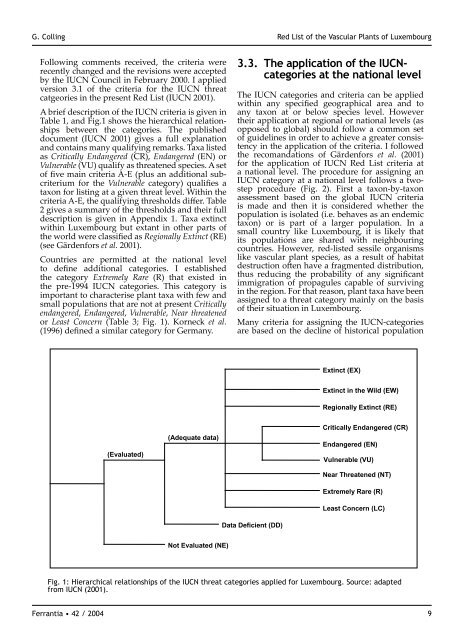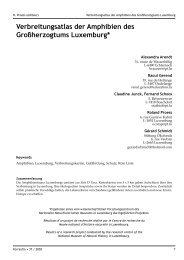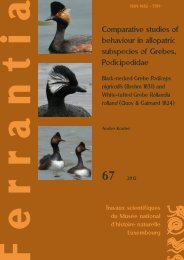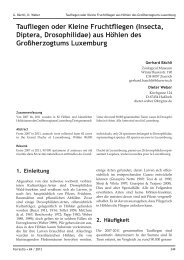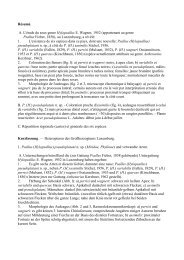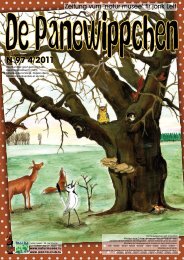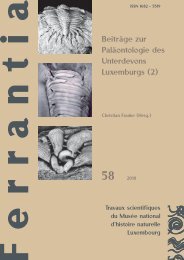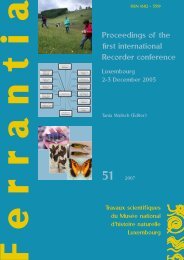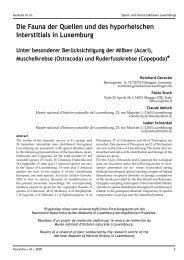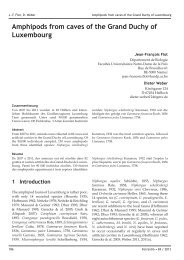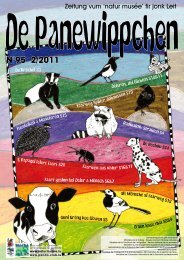Ferrantia 42 - Musée national d'histoire naturelle
Ferrantia 42 - Musée national d'histoire naturelle
Ferrantia 42 - Musée national d'histoire naturelle
You also want an ePaper? Increase the reach of your titles
YUMPU automatically turns print PDFs into web optimized ePapers that Google loves.
G. Colling Red List of the Vascular Plants of Luxembourg<br />
Following comments received, the criteria were<br />
recently changed and the revisions were accepted<br />
by the IUCN Council in February 2000. I applied<br />
version 3.1 of the criteria for the IUCN threat<br />
catgeories in the present Red List (IUCN 2001).<br />
A brief description of the IUCN criteria is given in<br />
Table 1, and Fig.1 shows the hierarchical relationships<br />
between the categories. The published<br />
document (IUCN 2001) gives a full explanation<br />
and contains many qualifying remarks. Taxa listed<br />
as Critically Endangered (CR), Endangered (EN) or<br />
Vulnerable (VU) qualify as threatened species. A set<br />
of five main criteria A-E (plus an additional subcriterium<br />
for the Vulnerable category) qualifies a<br />
taxon for listing at a given threat level. Within the<br />
criteria A-E, the qualifying thresholds differ. Table<br />
2 gives a summary of the thresholds and their full<br />
description is given in Appendix 1. Taxa extinct<br />
within Luxembourg but extant in other parts of<br />
the world were classified as Regionally Extinct (RE)<br />
(see Gärdenfors et al. 2001).<br />
Countries are permitted at the <strong>national</strong> level<br />
to define additional categories. I established<br />
the category Extremely Rare (R) that existed in<br />
the pre-1994 IUCN categories. This category is<br />
important to characterise plant taxa with few and<br />
small populations that are not at present Critically<br />
endangered, Endangered, Vulnerable, Near threatened<br />
or Least Concern (Table 3; Fig. 1). Korneck et al.<br />
(1996) defined a similar category for Germany.<br />
<strong>Ferrantia</strong> • <strong>42</strong> / 2004<br />
(Evaluated)<br />
(Adequate data)<br />
Not Evaluated (NE)<br />
3.3. The application of the IUCNcategories<br />
at the <strong>national</strong> level<br />
The IUCN categories and criteria can be applied<br />
within any specified geographical area and to<br />
any taxon at or below species level. However<br />
their application at regional or <strong>national</strong> levels (as<br />
opposed to global) should follow a common set<br />
of guidelines in order to achieve a greater consistency<br />
in the application of the criteria. I followed<br />
the recomandations of Gärdenfors et al. (2001)<br />
for the application of IUCN Red List criteria at<br />
a <strong>national</strong> level. The procedure for assigning an<br />
IUCN category at a <strong>national</strong> level follows a twostep<br />
procedure (Fig. 2). First a taxon-by-taxon<br />
assessment based on the global IUCN criteria<br />
is made and then it is considered whether the<br />
population is isolated (i.e. behaves as an endemic<br />
taxon) or is part of a larger population. In a<br />
small country like Luxembourg, it is likely that<br />
its populations are shared with neighbouring<br />
countries. However, red-listed sessile organisms<br />
like vascular plant species, as a result of habitat<br />
destruction often have a fragmented distribution,<br />
thus reducing the probability of any significant<br />
immigration of propagules capable of surviving<br />
in the region. For that reason, plant taxa have been<br />
assigned to a threat category mainly on the basis<br />
of their situation in Luxembourg.<br />
Many criteria for assigning the IUCN-categories<br />
are based on the decline of historical population<br />
Data Deficient (DD)<br />
Extinct (EX)<br />
Extinct in the Wild (EW)<br />
Regionally Extinct (RE)<br />
Critically Endangered (CR)<br />
Endangered (EN)<br />
Vulnerable (VU)<br />
Near Threatened (NT)<br />
Extremely Rare (R)<br />
Least Concern (LC)<br />
Fig. 1: Hierarchical relationships of the IUCN threat categories applied for Luxembourg. Source: adapted<br />
from IUCN (2001).<br />
9


